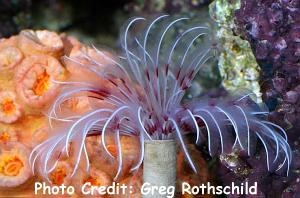
By Bob Goemans

Likely Reef Tank Suitable
Likely Fish-Only Tank Suitable
Range: Western Atlantic Ocean: Caribbean.
Natural Environment: Inhabits sandy and rubble regions along reefs.
General Husbandry: Occasionally seen in the home aquarium trade.
Sabellida worms, commonly called Feather Dusters, construct a leathery tube, sometimes up to 12 inches (30 cm) in length, from which they extend a single crown of multicolored feather-like filaments (usually a mottled reddish-brown and white) of about 4 inches (10 cm) in diameter.
Since they are usually found buried in sand or mud in the wild, and not adhered to or between rockwork high in the water column, they should be placed near the bottom of the aquarium. Furthermore, their tubes are constructed of sand, detritus, mucus, and other bits of sediment, simply another reason why it's better to locate these worms near the bottom of the aquarium where this type material is more plentiful. Also, particulate matter content is often higher near the bottom of the aquarium and since they are only suspension feeders, not photosynthetic animals, it's another good reason to place them in this area.
These 'Feather Dusters' use their slime-coated filaments/tentacles or "feathers" as some call them, for respiration and to collect suspended particulate matter/plankton. The collected matter is then drawn towards the mouth area at the center of the tentacle ring. Feeding solutions should be applied near and under the crown of feathers so it can normally be drawn up and to the beating cilia on the feathers. These tiny hair-like extensions actually generate the current that draws the food supply into the feather-like head of this animal. Frequent feedings, at least every other day, with fresh or preserved zooplankton (rotifers/Cyclop-eeze) and phytoplankton additives are a must for long term survival. Keep in mind that dispensing the feeding solution above the animal may cause the animal to retract with most of the feeding solution going to waste.
Feather dusters may lose their crown of "feathers" for many reasons, some being: poor water quality; being disturbed too often; or, lack of sufficient nutrition. This does not mean they are dead as most will grow their feathers back in a month or so. If the head/crown of feathers returns and is smaller, this is an indication the food supply is inadequate. Could be if this happens again and the head comes back again smaller, the tubeworm will die. Always wait a couple of months and if no reappearance occurs, feel the tube for the worm body inside. If there is some movement inside the tube, put it back and be patient for another month.
Taxonomy:
Kingdom: Animalia
Phylum: Annelida
Class: Polychaeta
Order: Sabellida
Family: Sabellidae
Genus: Sabellastarte
FYI: When it comes to keeping any of the ornamental type worms, predators like triggerfish, wrasses, angelfish, most shrimp, and the arrow crab will not make suitable tankmates.
Experience Level: Intermediate
Diet: Filter feeder
Aquarium Environment: Reef or fish-only aquarium
Coral Safe: Yes
Fish Safe: Yes
Invertebrate Safe: Yes
Acclimation Time: >15 minutes.
Aquarium Hardiness: Moderate
Temperature Range: 72 - 79°F (22 - 26°C)
Minimum Tank Size: 50 gallons
Lighting: PAR ratings N/A
Water Movement: WM 1 - 2
Specific Gravity: 1.023 - 1.025
pH: 8.0 - 8.4
